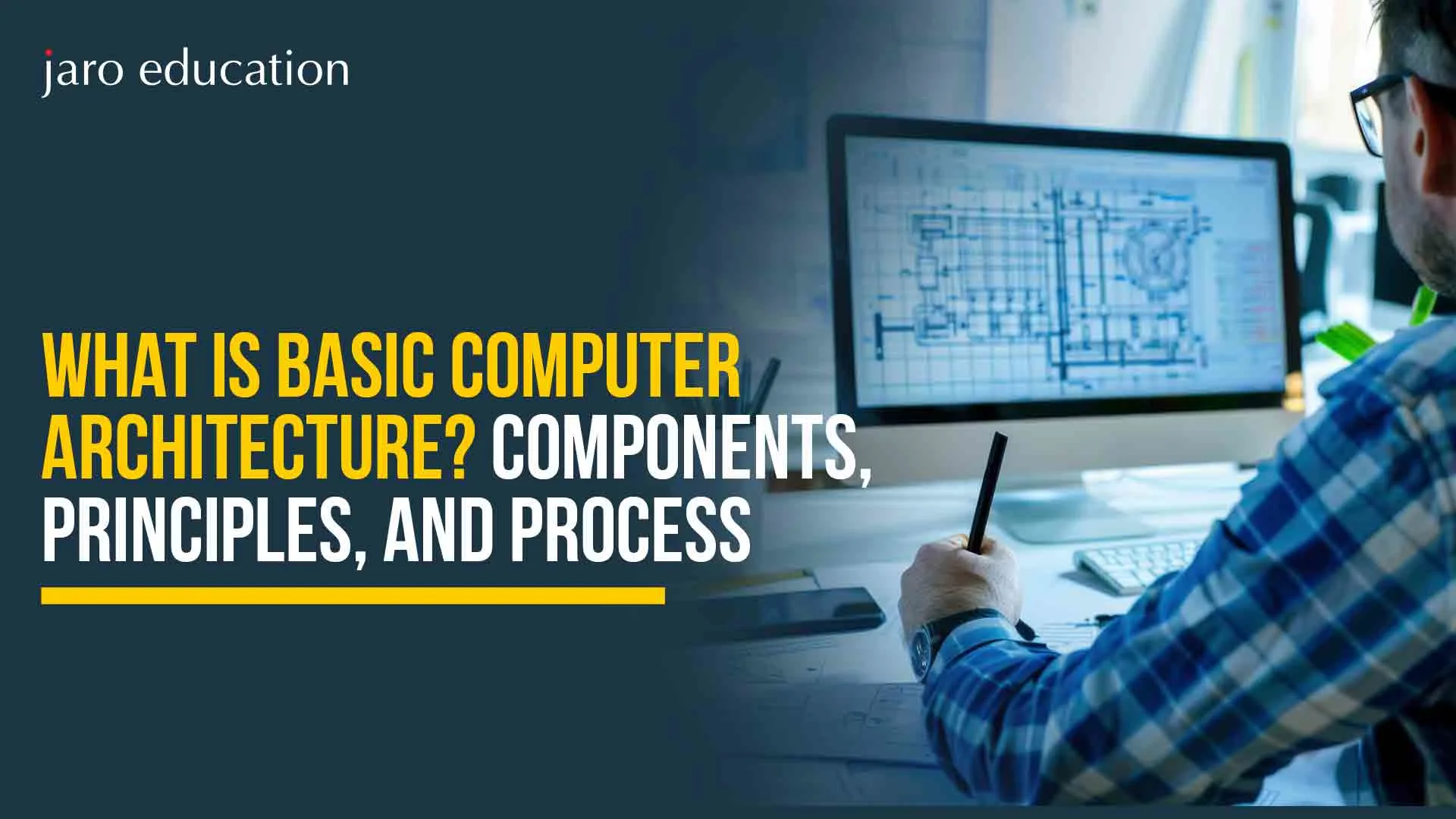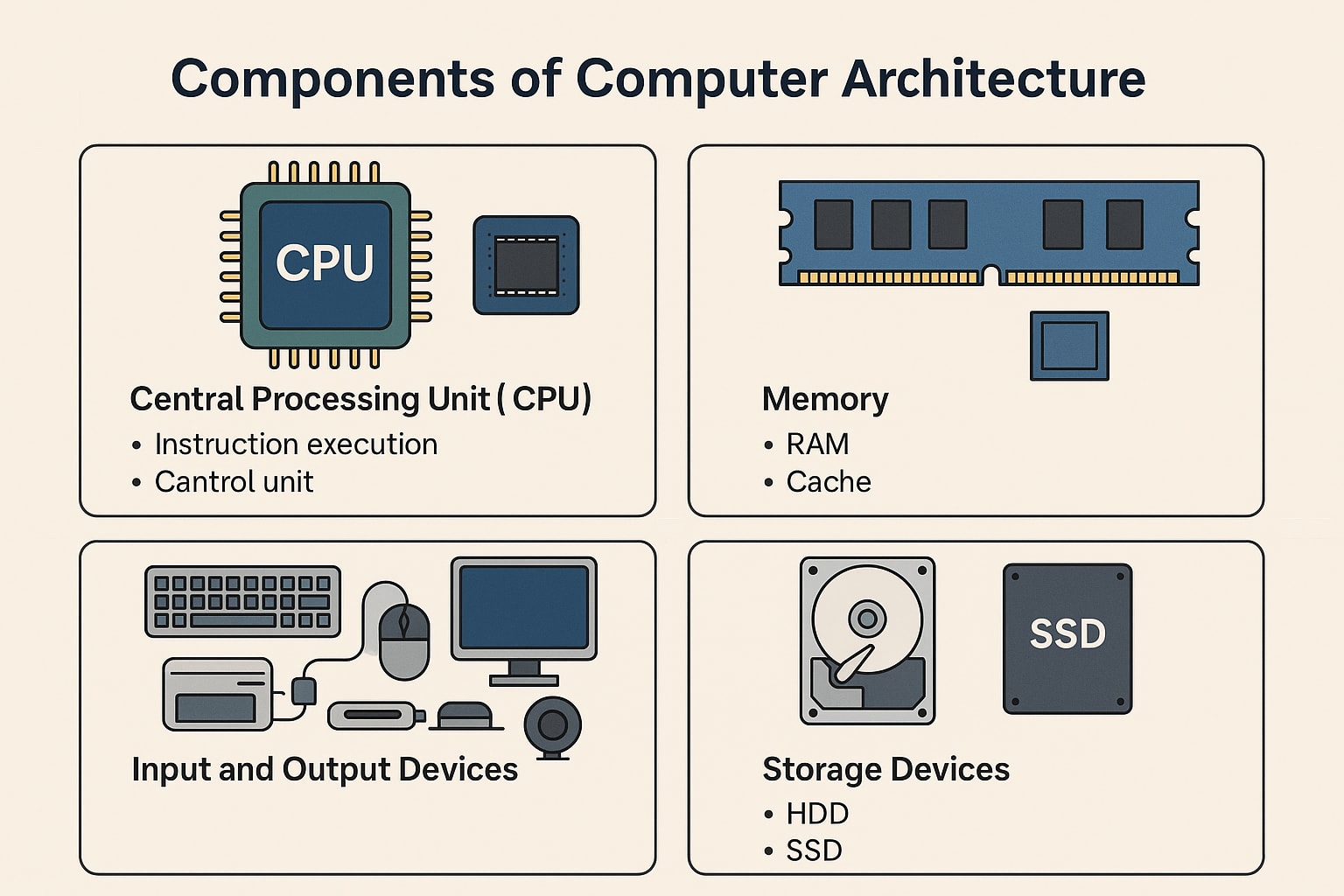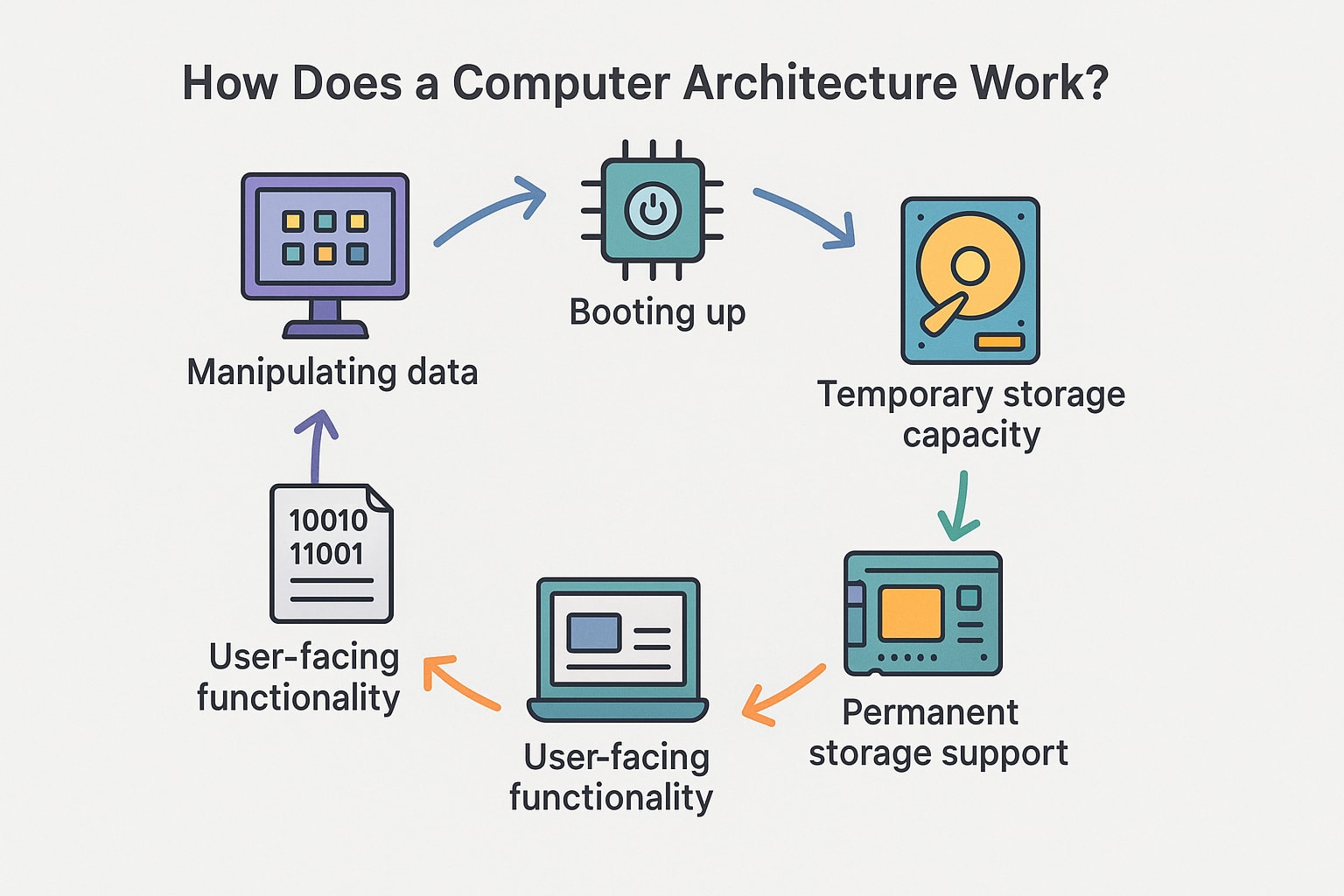What Is Basic Computer Architecture? Components, Principles, and Process
Table of Contents

- jaro Education
- 13, March 2023
- 1:29 pm
Did you know that more than 90% of the world uses a digital device every day, yet relatively few people know HOW a computer works? This is where Computer Architecture comes into play. Computer Architecture specifies the design of every computer system, describing how hardware and software components interact to perform a useful task reliably and efficiently. Accordingly, if you ever asked yourself the question, “What is computer architecture?”, you could think of it as the master blueprint behind every mouse click, scroll, or touchscreen tap.
In this blog, we will have a look at the login computer architecture, its key components, functions, and processes, as well as the types of computer architecture, in simple terms.
What is Computer Architecture?
Computer architecture is a basic idea in the study of computer science. Basic Computer architecture is a framework for comprehending how computers work and how their components function to perform tasks. Computer architecture comprises hardware, software, and communication components.
The operation of a computer system depends on the central processing unit (CPU), memory, input/output devices, and storage devices, which are called the computer architecture. To have a greater grasp of how computers work, as well as their capabilities and limitations. It is essential to understand the fundamental functions and capabilities of each of these components.
Components of Computer Architecture
Grasping the elements of computer architecture is crucial if you are looking to learn what computer architecture is and how a computer works from the inside out. Let’s look at the base components of computer architecture.

- Central Processing Unit (CPU)
The CPU is often referred to as the “brain” of the computer, as it is the center of all relayed operations in computer system architecture, where the CPU fetches, decodes, and executes sets of instructions at a high rate.
Key features: instruction execution, control unit, ALU (Arithmetic Logic Unit)
Types of CPU Architectures:
RISC (Reduced Instruction Set Computer)
CISC (Complex Instruction Set Computer)
These types of computer architectures are designed for various aspects of performance and efficiency in the task of processor architecture, whether or not simplified code statements are used.
- Memory (RAM, Cache)
Memory is an important element of computer architecture because it is the temporary storage unit used to hold short-term task data from users for processing by the CPU.
Types of Memory:
RAM: volatile, fast
Cache Memory: smaller, faster, and lighter, connecting to the CPU
Memory hierarchy: In defining a way to work with memory types will usually identify the speed and associated memory type cost to provide ease of access to data.
- Input and Output Devices
Users and external systems communicate through an I/O device, which provides a communication link between the system and external devices.
An input device includes a keyboard, a mouse, and a scanner.
An output device includes a monitor, printer, and speakers. These are critical to understand basic computer architecture as they represent a point of entry for data as well as presentation for data.
- Storage Devices
Unlike memory, the purpose of a storage device is to provide long-term storage for all programs, files, and the operating system.
Primary Examples Are As Follows:
HDD (Hard Disk Drive) – High capacity but relatively slow.
SSD (Solid State Drive) – Fast, fairly durable, and energy efficient.
Storage devices are the foundation of the computer system architecture to support persistent data retention.
Computer Architecture Design Principles
- Von Neumann Architecture
Computers built according to the Von Neumann architecture segregate memory data from the program instructions and use a single bus to transport data between the memory and the CPU. The description of Von Neumann Architecture, its benefits and drawbacks, and the produced adaptations will all be covered in this section.
- Instruction Set Architectures
A computer’s collection of executable instructions and their format are specified by Instruction Set Architectures (ISA). An overview of ISA, its several varieties, and how they impact a computer system’s performance and adaptability is given in this section.
- Parallel Processing
The employment of numerous processing components, such as CPUs or GPUs, in tandem to carry out instructions, is known as parallel processing. An overview of parallel processing, its various varieties, and its benefits for enhancing computer systems’ performance is provided in this section.
How Does a Computer Architecture Work?
Basic Computer architecture provides a platform for computing, storing, and searching information. This could be a number in a spreadsheet, lines in the text of a file, entities of color in an image, or sounds or status in a system such as a flash drive.

Purpose of Basic Computer Architecture: Yes, almost everything that happens in a system is related to the computer handling some kind of numeric data processing—understanding that corresponds to surfing the web or printing something out. What a computer does is a mathematical system meant to gather, process, and elucidate numbers.
Data in numbers: A numeral is the way any information is stored by a computer. This truth is easily forgotten by the developer obsessed with lines in machine learning code that manipulate advanced algorithms and data structures.
Manipulating data: All management of information on computers is carried out through numerical processing. Transmit a matrix of numbers to video memory for each pixel of color, and voilà, an image appears on the screen.
Multifaceted functions: Basic computer architecture components are both soft and hard. Any basic computer has at least a processor, which is hardware that executes the computer programs.
Booting up: At the most elementary level of computer design, while the computer is switched on, programs executed by the processor of a computer will perform the configuration of the proper functioning of such a computer, known as firmware, and initialize the various component hardware into a known state.
Temporary storage capacity: Memory, an essential component of computer architecture, typically encompasses several types within a single system. Memory is where the programs (applications) are stored while being executed by the processor and the data being manipulated by the applications.
Permanent storage support: For example, such a computer system contains means for storing data or sending information to the outer world using the input by text keyed into the keyboard, the presentation of knowledge on the monitor, and the transfer of programs and data from or to the hard disc drive.
User-facing functionality: Software rules how a computer operates and works. There are several ‘layers’ of software in basic computer architecture. Typically, a layer would only interface with layers below or above it.
This is how basic computer architecture works: booting. Then, once everything is good for the loading of its firmware, the rest could initialize the rest of the basic computer architecture to make it run smoothly; that is, help the user find, consume, and work with data in many different forms.
Challenges and Trends in Computer Architecture
Challenges in Basic Computer Architecture
- Affects the speed and efficiency of computer architecture
- Affected by CPU, memory, storage devices, and bandwidth
- Requires regular maintenance and optimisation
- Requires more energy to function
- Higher energy costs and environmental impacts
Emerging Trends in Computer Architecture
- Machine Learning and Artificial Intelligence (AI) help in data analysis, natural language processing, and computer vision.
- Quantum Computing uses quantum bits (qubits) to perform computations, solve intractable problems with classical computing, and simulate quantum systems.
- The structure and function of the human brain inspire neuromorphic computing. It performs tasks such as pattern recognition and decision-making in an energy-efficient manner.
- Memristors are electronic components that remember the amount of charge that has passed through them. This property makes them useful for building non-volatile memory and analogue computing circuits.
- 3D stacked memory is a technology involving stacking multiple layers of memory chips on top of each other to increase memory systems’ storage density and bandwidth.
Online MCA Programme
An online master’s in computer applications would be appropriate for you if you wish to go deeper and comprehend the subtleties of basic computer architecture. Cloud computing technology, exams, practicals, and projects are all covered in this online MCA degree. You cannot quit your current work if you want to register in this MCA program at Manipal University, Jaipur. One of the best online MCA programs has the additional benefit of having a short course duration. Unlike other full-time programs, you won’t need to devote much time to this online MCA course. The most amazing advantage is that it gives huge corporations more opportunities.
Uplift Your Career with Jaro Education’s Industry-Focused Programs
At Jaro Education, we understand that choosing the right career path is both crucial and complex. That’s why we focus on bridging career gaps with a clear perspective and tailored support. Whether you are a fresh graduate or a working professional seeking to upskill or advance, Jaro Education offers expert career counseling to help navigate the challenges you may face.
Our experienced mentors provide practical insights and guidance—from identifying your strengths and career interests to selecting the right courses and securing counselling and placements. With Jaro Education, you’ll receive the support you need to reach your professional goals and scale new heights in your career.
Conclusion
In conclusion, everybody working in the field of computers must have a basic understanding of computer architecture and the parts that make it up. The design and construction of computer systems that satisfy the performance and energy efficiency criteria of their intended usage benefits from a thorough grasp of computer architecture. The processor, memory, storage, and I/O subsystems—components of computer architecture—work together to create a computer system that can run programs and handle data. Last but not least, keeping up with the newest developments in computing technology requires awareness of new trends and issues in computer design.
Frequently Asked Questions
Computer architecture refers to the design and organization of a computer’s core components — including the CPU, memory, and input/output systems. It’s important because it determines a system’s performance, efficiency, and compatibility with software.
Basic computer architecture works by coordinating components like the control unit, ALU, memory, and buses to process data and execute instructions. It’s the foundation that supports all computer operations.
Yes, to define computer architecture, think of it as the blueprint or framework that guides how a computer is built and how its internal parts communicate and function together.
The main types of computer architecture include:
- Von Neumann architecture
- Harvard architecture
- RISC (Reduced Instruction Set Computing)
- CISC (Complex Instruction Set Computing)
Each type impacts speed, complexity, and energy efficiency.
While computer architecture focuses on the design of the system’s components, computer system architecture includes both the hardware and system-level software that work together for computing tasks.










